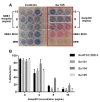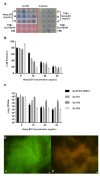Chromatographic Analyses, In Vitro Biological Activities, and Cytotoxicity of Cannabis sativa L. Essential Oil: A Multidisciplinary Study
- PMID: 30544765
- PMCID: PMC6320915
- DOI: 10.3390/molecules23123266
Chromatographic Analyses, In Vitro Biological Activities, and Cytotoxicity of Cannabis sativa L. Essential Oil: A Multidisciplinary Study
Abstract
Due to renewed interest in the cultivation and production of Italian Cannabis sativa L., we proposed a multi-methodological approach to explore chemically and biologically both the essential oil and the aromatic water of this plant. We reported the chemical composition in terms of cannabinoid content, volatile component, phenolic and flavonoid pattern, and color characteristics. Then, we demonstrated the ethnopharmacological relevance of this plant cultivated in Italy as a source of antioxidant compounds toward a large panel of enzymes (pancreatic lipase, α-amylase, α-glucosidase, and cholinesterases) and selected clinically relevant, multidrug-sensible, and multidrug-resistant microbial strains (Staphylococcus aureus, Helicobacter pylori, Candida, and Malassezia spp.), evaluating the cytotoxic effects against normal and malignant cell lines. Preliminary in vivo cytotoxicity was also performed on Galleria mellonella larvae. The results corroborate the use of this natural product as a rich source of important biologically active molecules with particular emphasis on the role exerted by naringenin, one of the most important secondary metabolites.
Keywords: Cannabis sativa L.; Galleria mellonella; antimicrobial activity; antioxidant activity; biofilm; cancer cell cytotoxicity; chromatographic analysis; essential oil; naringenin.
Conflict of interest statement
The authors declare no competing financial interests.
Figures





References
-
- Gazzetta Ufficiale della Repubblica Italiana LEGGE 2 Dicembre 2016, n. 242 Disposizioni Per La Promozione Della Coltivazione e Della Filiera Agroindustriale Della Canapa. [(accessed on 08 December 2018)]; Available online: http://www.gazzettaufficiale.it/eli/id/2016/12/30/16G00258/sg.
-
- Fernández-Ruiz J., Sagredo O., Pazos M.R., García C., Pertwee R., Mechoulam R., Martínez-Orgado J. Cannabidiol for neurodegenerative disorders: Important new clinical applications for this phytocannabinoid? Br. J. Clin. Pharmacol. 2013;75:323–333. doi: 10.1111/j.1365-2125.2012.04341.x. - DOI - PMC - PubMed
-
- Amaducci M.T. Ricerche sulla tecnica colturale delle canape monoiche utilizzate per fabbricazione di carte pregiate. Sementi Elette. 1969;3:166–179.
-
- Benelli G., Pavela R., Lupidi G., Nabissi M., Petrelli R., Ngahang Kamte S.L., Cappellacci L., Fiorini D., Sut S., Dall’Acqua S., et al. The crop-residue of fiber hemp cv. Futura 75: From a waste product to a source of botanical insecticides. Environ. Sci. Pollut. Res. Int. 2018;25:10515–10525. doi: 10.1007/s11356-017-0635-5. - DOI - PubMed
MeSH terms
Substances
LinkOut - more resources
Full Text Sources
Miscellaneous

